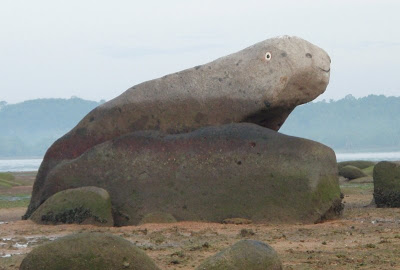70th Discovery Posting:
Frog Island otherwise known as Pulau Sekudu (first time going there) was our destination for the morning (our boat was leaving at 430am from the jetty, so it meant another climbing out of my bed in the wee hours of the morning...)
You might wonder/ask why is this place known as Frog Island? Look at the picture below to get an idea.
 This is probably because there is a large boulder on the island which is in the shape of a frog. And someone has even added eyes to the boulder to aid in your imagination along... hahaha
This is probably because there is a large boulder on the island which is in the shape of a frog. And someone has even added eyes to the boulder to aid in your imagination along... hahahaWell, for a second fact, this island is actually located within Singapore waters. Here's a map which I got from the internet to give everyone a better idea where the island is (picture below). '+' marks the spot.
 Side note:
Side note:Map retrieved from http://sg.pagenation.com/sin/Pulau%20Sekudu_103.9878_1.4048.map
As you can see, Pulau Sekudu is an island near Pulau Ubin and it is also located very near to Chek Jawa, one could possibly say there is the crown jewel of Pulau Ubin.
By the way, there is no jetty on this island, so we had to climb a ladder off the boat once we reached the island. Another first for me. =P
Well, there's also a urban legend/story which tells us why Pulau Sekudu is also known as Frog Island.
The story goes like this (a short version),
Long before your time, 3 animals, an elephant, a pig and a frog lined up along the coast of Changi in a swimming race from Changi to Johor.
As they raced, the frog drown halfway through the race (I'm still wondering why, as I feel frogs should be better swimmers compared to elephants and pigs) and thus formed Pulau Sekudu.
Well, the elephant and pig didn't complete the race as well, in fact they drown a little further up from the frog drown, and so the two animals formed the island of Pulau Ubin.
Anyways, first 'discovery' is something which is really big in numbers (for me) on that island, peacock anemone (pictures below). I counted about 50 of them before I gave up counting...

 Discovery Note:
Discovery Note:1. To see their full beauty, you will need to see them in a certain depth of water, like above.
2. The long small things around the ring of the anemone are actually tentacles, and there are two types of tentacles, one on the outer ring while the other on the inner ring.
3. The tentacles on the outer ring gathers food (plankton) are called the marginal tentacles and the tentacles on the inner ring (which are usually shorter) are called oral tentacles is for manipulating food into its mouth located in the center.
4. Their 'home' is a tube found below the mouth area, therefore they are also known as tube anemones.
5. Click here to read more about them.
Second 'discovery' is a fish which I have never seen before. Thanks to CH, I finally know what this fish is. This is most likely to be a long tail tripod fish (picture below).
 Discovery Note:
Discovery Note:1. As I observed the fish going around me, probably finding food amongst the seagrass and seaweed, it was swimming in a very strange matter.
2. I could say that it swim with one side of its body during most of the time as I was looking at it.
3. Is this a playing dead act by the fish cause it thinks that I may be a predator?
Third 'discovery' is a nudibranch which I've never seen before. This possibly might be a Discodoris lilacina (picture below).
 Discovery Note:
Discovery Note:1. Nudibranch means naked gills. They are also sea slugs but not all sea slugs are nudibranchs.
2. They are often very colourful/attractive, a warning sign in the natural world. Telling predators that eat me if you dare, cause you might die trying to do so or after you have done so.
3. Some nudibranchs have other forms defences for survival. For example: some nudibranchs feed on things which have stinging cells and they somehow store these stinging cells on themselves also, thus when the nudibranch can release the stinging cells when being threaten.
Fourth 'discovery' is also a first sighting for me, an orange rock star (picture below)!
 Discovery Note:
Discovery Note:1. The rock stars I've seen are usually brownish in colour, like the colour of rocks, probably for camouflage purposes.
2. Thus to find an orange individual is considered a uncommon sight (for me, that is).
Well, of course, we couldn't miss the 'die-die' can see attraction of this island, the frog rock with eyes and even a smiley face (picture below). =P
 Finally, it's thanks to RY for organising this trip for us and everyone who made this trip another fun-filled trip. =)
Finally, it's thanks to RY for organising this trip for us and everyone who made this trip another fun-filled trip. =)Extra:
Read RY's aka Tidechaser's blog posting for other marine creatures we saw during this trip.
No comments:
Post a Comment